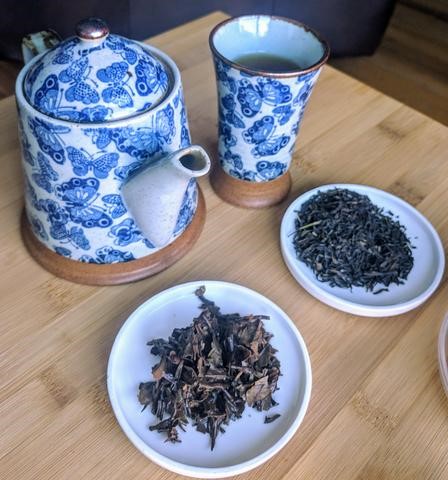There are so many teas out there, I learn about a new one all the time. My father asked for darjeeling tea so I went out and bought some but have no idea what the name means, Margaret’s Hope, second flush, Darjeeling tea. I had heard of Darjeeling tea but really didn’t know what it was.

What is Darjeeling tea?
Darjeeling tea is tea from this district in West Bengal India called the Darjeeling district. This area is in the Himalayas. It’s tea grown here. The soil and climate is such that the teas created here have an taste that gives it the distinction of being referred to as the “champagne of teas”. The flavour of Darjeeling teas go well with custard, eggs, grilled fish, curries and fresh fruit. So pretty much everything! There are 87 tea gardens, as they are called, places that grow tea in this area. These tea estates cover over 17500hectares of land and produce over 9 million kilograms of tea per year and employ over 50 percent of the people in this Darjeeling district.
The history of Darjeeling tea
A bit of history of tea planting in this district and how it came to be. Tea planting in this Darjeeling district began in 1841 by Archibald Campbell. He was a Civil surgeon in the Indian Medical Service. Dr. Campbell was transferred to Darjeeling as superintendent in 1839 from Kathmandu, Nepal. In 1841 he brought some of the Chinese tea plant, Camellia sinensis, seeds and started planting them in Darjeeling. Over time other tea nurseries were started by the British government and then commercialization of the teas began in the 1850’s. In the mid 1850’s other tea gardens started opening up such as Alubari tea garden were opened by the Kurseong and Darjeeling Tea company.
Tea types for Darjeeling
Darjeeling tea, while commonly made a black tea, isn’t limited to just black teas. Darjeeling oolong and green teas are becoming more common place. From my understanding, the Camellia sinensis var sinensis variety of the plant, normally found in China is used to make the Darjeeling teas rather than the more commonly found Camellia sinenesis var assamica used to create the Indian teas. The flavour of Darjeeling teas seems quite varied in taste and flavour, from astringent tannic to musky spiciness or “muscatel”. That’s an interesting word, originally used to describe wine and characteristic sweet floral aroma, but has been used to describe tea. Another interest topic of discussion.
It seems that depending on when the Darjeeling is harvested results in the varieties of Darjeeling teas such as oolong and green teas. If there is a particular harsh winter, incomplete oxidation occurs resulting in an oolong type tea. Some of the Darjeeling teas are oxidized to green tea levels of oxidation resulting in a green tea. From here we have the ideas of first flush and second flush of teas. The idea of “flush” ties in with when the tea has been harvested.
Harvesting of tea
First flush teas are those harvested early on in mid March after the spring rains. So around this time. They have a gentle, very light colour and aroma and mildly astringent.
Second Flush teas are those harvested a little later in June. These teas are more amber, full bodied and have this elusive muscatel flavour.
There seem to be a few other harvest times, in between is just that, tea harvested in between the first and second flush. Autumnal flush are teas that are harvested in the autumn after the rainy season. These teas have a less delicate flavour, less spicy, but fuller body and darker colour. Monsoon or rains teas are those teas that are harvested between the second flush and the autumnal flush. These Monsoon teas are less withered, more oxidized, less expensive and rarely exported. They are usually used in masala chai, another tea type to talk about!
What is Margaret’s Hope Darjeeling tea?
Now that we have a bit of an understanding of what a Darjeeling tea is, I went out and bought some for my father, a Margaret’s Hope, second flush, Darjeeling tea, to be exact. I know what Darjeeling tea is, what second flush means, but who is Margaret’s Hope? It seems there was a tea garden originally called Bara Ringtong in 1830 became known as Margaret’s Hope Estate almost 100 years later in 1927. Why, you may ask? Well, it seems the tea estate owner of this Bara Ringtong tea estate had a daughter, Margaret, who fell in love with this garden. Margaret was returning to England but promised to return back to the garden. Unfortunately, she because sick on the journey home to England and died. Her father renamed the tea estate in her memory and hence the name, Margaret’s Hope.
Now we know the story and meaning behind, Margaret’s Hope, second flush, Darjeeling tea.
References:
- Darjeeling – Margaret’s Hope Estate, 2nd Flush Tea, Simpson and Vail Inc., http://www.svtea.com/, Url:
- http://www.svtea.com/Darjeeling-Margarets-Hope-Estate-2nd-Flush-Tea/productinfo/T0041/
- Darjeeling Tea, URL: https://en.wikipedia.org/wiki/Darjeeling_tea
- Everyone will love this hazelnut spread stuffed cookies recipe - November 18, 2024
- The Greely Good Market is a Modern Outdoor Market - September 3, 2024
- Our Quick Visit to the Petawawa Container Market - September 3, 2024











